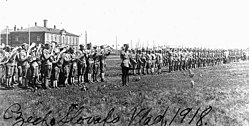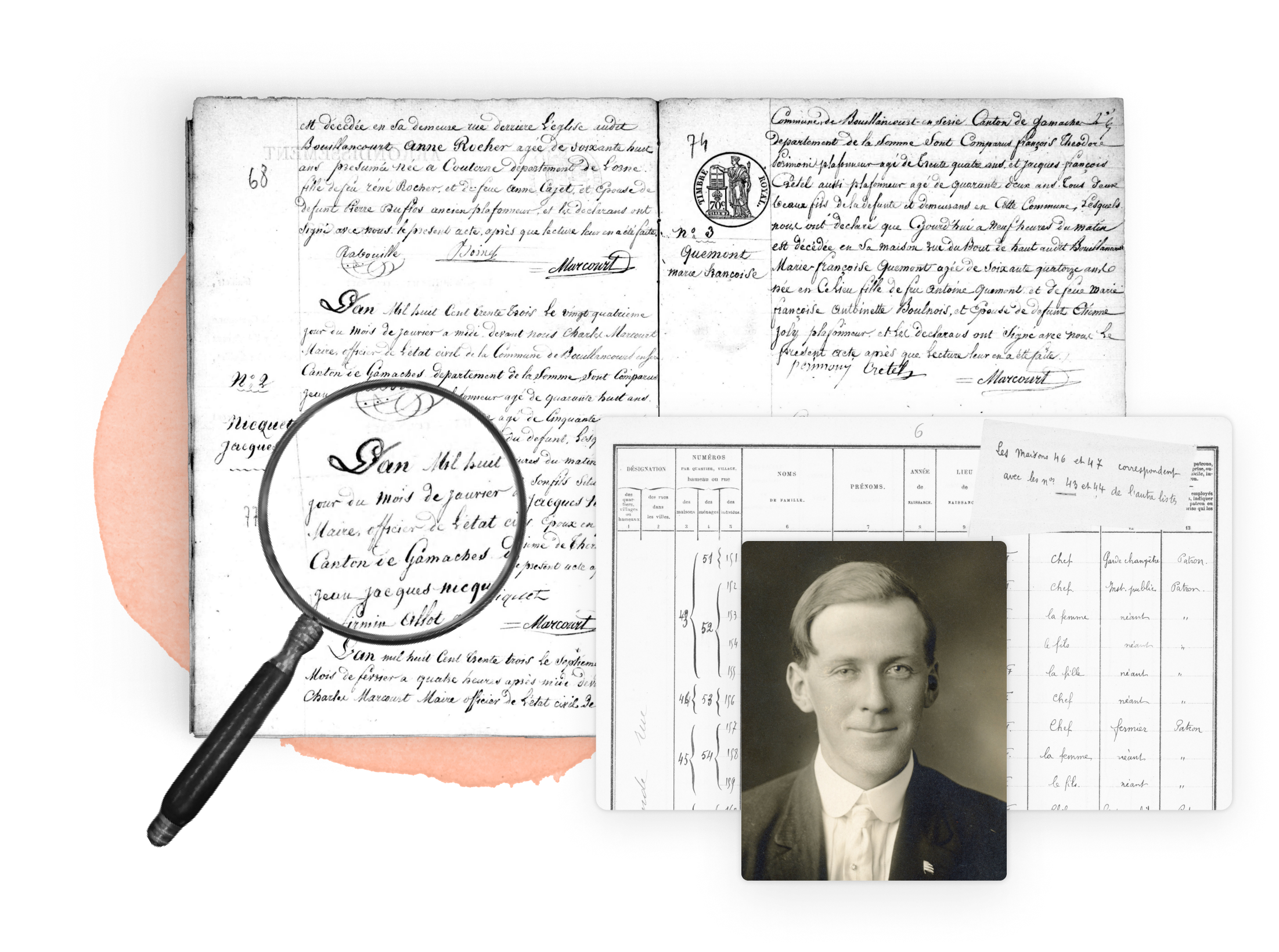The Russian Civil War was a conflict which occurred over a five and a half year period between the Russian Revolution of 1917 through to 1923. It was fought by a broad array of different factions and groups with varying objectives, generally divided into the Bolshevik communists or Reds and their opponents, a disparate alliance of different groups known as the Whites. To complicate matters the civil war also involved numerous wars of independence in former constituent parts of the Russian Empire where Finnish, Polish, Lithuanian, Estonian, Latvian and Ukrainian nationalists tried to use the unrest within Russia to achieve their own independent states. Britain, the United States and other countries also became involved in the conflict supplying aid to the opponents of the Reds. This series of conflicts led to the deaths of millions of people and the migration of several million more as people were displaced from Finland and Poland in the west to the Pacific Ocean in the east.[1]
Research your ancestors on MyHeritage
Russian Civil War chronology of events

By the time Russia mobilized to enter what would become the First World War in late July of 1914 to defend its ally Serbia against Austro-Hungarian aggression the Russian Empire had endured decades of internal instability. This was brought about by a backwards, autocratic political system and an economy which was beginning to industrialize, bringing about major social change in the process as the emergence of radical political movements such as the communists and the anarchists. Perhaps unsurprisingly, when Russia began experiencing major defeats to Germany and Austria-Hungary in the course of 1914, 1915 and 1916 the political situation became terminal at home. A coup d'état in February 1917 in St Petersburg brought about the initial downfall of Tsar Nicholas II and the imperial government, but this conservative revolution was simply a prelude to the communist revolution of October/November 1917. With this the Bolsheviks under Vladimir Lenin seized power.[2]
While Lenin and his followers had secured control of the central government, it was a much more difficult thing for them to secure the rest of the country. Many groups were determined to resist them and so the Russian Civil War, a five and a half year conflict, followed from the Russian Revolution. At the heart of the conflicts were the Bolshevik communists or Reds who controlled the central government in Moscow and St Petersburg, which they subsequently renamed Leningrad after Lenin. They were opposed by an amorphous group of opponents known as the Whites, comprised of the Russian aristocracy and various centrist and conservative political groupings, the Menshevik communists who opposed the Bolsheviks, and regional groups such as the Cossacks of Ukraine and south-western Russia.[3]

To compound matters this central struggle within Russia itself was further complicated by the outbreak of numerous wars of independence in Eastern Europe as the Poles, Finns, Lithuanians, Latvians, Estonians and Ukrainians tried to exploit the unrest in Russia to establish their own nation states after over a century or more of being subsumed within the Russian Empire. Finally, a number of foreign powers such as Britain, France and the United States, which were alarmed by the rise to power of these radical socialists, became involved by providing significant logistical aid to the Whites and various groups such as the Poles, while also dispatching expeditionary forces to Russia itself to fight the Reds.[4] The famous Czechoslovak Legion, a contingent of Austro-Hungarian prisoners-of-war that had been interred in camps in Asian Russian prior to the revolution of 1917, even became involved, revolting as they were being transferred home to Central Europe and seizing control of much of the Trans-Siberian Railway in 1918. As such, the Russian Civil War was an international conflict.[5]
The war eventually ended in victory for the Bolshevik Reds after years of brutal fighting. Millions died, although the exact figure remains a matter of significant academic debate. It seems probable that upwards of five million people lost their lives directly as a result of the conflict between 1917 and 1923, but the figure might have been higher. Millions more people were displaced and hundreds of thousands left the former lands of the Russian Empire altogether. Moreover, because Finland, Poland, Latvia, Lithuania and Estonia all emerged as independent nation states during the civil war there was extensive movement of people around Eastern Europe.[6]
Extent of migration during and after the Russian Civil War
It has been estimated that anywhere between one and two million people were displaced as a result of the Russian Civil War. A huge proportion of these were Russian Whites who fled from Russian as the Bolsheviks’ control of the country was solidified. Many headed into exile in countries like Britain and France or even as far afield as the United States and Canada where an influx of Russian Jews and other groups had already been occurring for many years prior to the First World War. There was also a large amount of migration associated with the emergence of the new nation states of Poland, Finland, Latvia, Lithuania and Estonia during the civil war, with Finns, Poles and other who found themselves still trapped within the territory of the new USSR in the early 1920s migrating westwards into Poland, Finland and other countries.[7]
Demographic impact of the Russian Civil War
As with any refugee crisis, in the initial stages of the Russian Civil War people fled to the nearest point of relative safety. This led to an influx of Russian emigres into places like Poland, the Baltic States region, Turkey and the Caucasus. However, it was not long before these regions were also mired in conflict as the end of the First World War opened up a half a decade of revolutions and wars of independence across Europe which were even bloodier than the war itself. Accordingly, over time many Russian migrants headed further still from Russia to countries like Britain, France, Germany and the United States, while the diaspora which emerged from the conflict even included tens of thousands of people in Latin America. In decades to come, as the Soviet Union expanded its control further again across Eastern Europe and into Central Europe in the aftermath of the Second World War, many Russians who had settled in countries like Hungary, Poland and Germany in the 1920s again took flight and left for new countries in the 1940s and 1950s such as Australia and New Zealand. Hence, the contribution of the Russian Civil War to the Russian diaspora has been immense.[8]
See also
Explore more about the Russian Civil War
- Russia, Cemetery Records record collection on MyHeritage
- Soviet Union, Soldier Memorials, 1915-1950 record collection on MyHeritage
- Zooming In on a Stunningly Hi-Res Photo from Imperial Russia at the MyHeritage blog
- Russians Immigrating to the United States record collection on MyHeritage
- Immigrants from the Russian Empire, 1898 to 1922 from the Likacheff-Ragosine-Mathers collection at Library and Archives Canada
References
- ↑ Russian Civil War. History Channel
- ↑ Timeline of the Russian Revolution. British Library
- ↑ The Russian Civil War: the White’s War to Lose. Retrospect Journal.
- ↑ Review: Allied Intervention and the Russian Civil War, 1917-1922. The International History Review
- ↑ Czechoslovak Legion: Marching to Freedom in the Russian Civil War. The Collector
- ↑ Continuing Conflict: Europe after the First World War. Imperial War Museums
- ↑ The Russian Refugee Crisis of the 1920s. British Library
- ↑ Russia, Ukraine and the forgotten exiles of the 1920s. The Spectator


